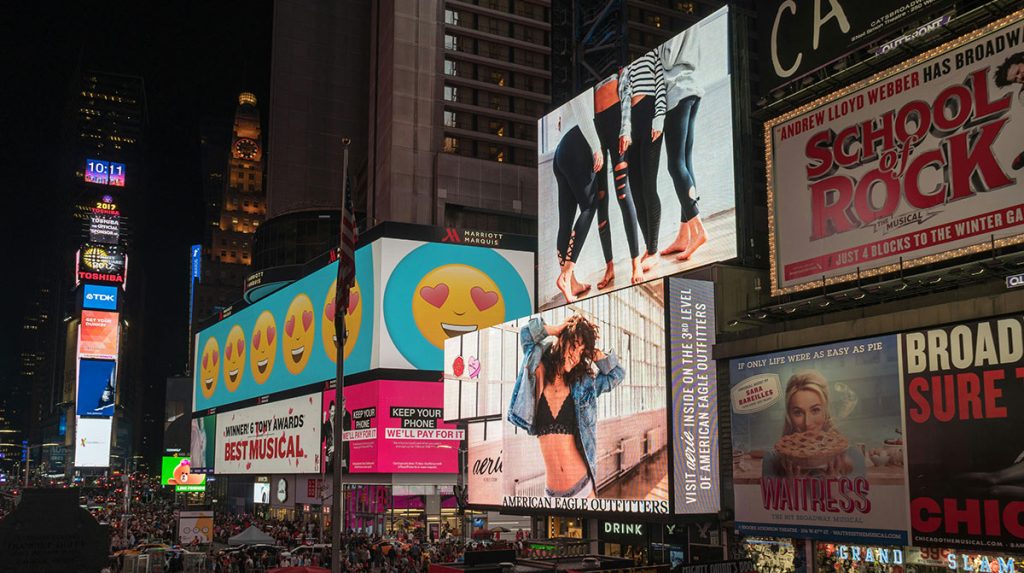The Evolution of Digital Billboards: How Technology is Transforming Outdoor Advertising

The digital landscape continues to reshape traditional marketing strategies, with outdoor advertising experiencing a significant evolution in recent years. One prominent player in this transformation is the digital billboard, a dynamic medium that harnesses technology to captivate audiences like never before.
These massive screens towering over highways and city centers are no longer static images but vibrant, interactive displays that engage passersby in real-time. The seamless integration of technology into outdoor advertising has opened up a realm of possibilities, allowing advertisers to deliver targeted, dynamic content to a diverse audience.
This shift from static to dynamic content not only revolutionizes the way brands communicate but also enhances the overall impact of outdoor advertising campaigns. By harnessing the power of technology, marketers can now tailor their messages with precision, ensuring maximum relevance and resonance with their target demographic.
As we look into the evolution of digital billboards, we’ll explore how technology is reshaping outdoor advertising, revolutionizing the way brands connect with consumers in the physical world.
Traditional Billboards vs. Digital Billboards
In the realm of outdoor advertising, traditional billboards have long been a staple, while digital billboards represent a more modern and dynamic approach to captivating audiences. Let’s delve into the defining attributes of these two distinct forms of outdoor advertising.
Definition and Characteristics of Traditional Billboards
Traditional billboards are static, non-digital displays commonly seen along highways, busy streets, and in high-traffic urban areas. These billboards typically feature a printed vinyl or paper advertisement mounted on a large board. The content on traditional billboards remains static for the duration of the advertising campaign, offering a consistent message to passersby.
Characteristics of Traditional Billboards:
- Static display with a fixed message.
- Printed on durable materials like vinyl or paper.
- Limited in terms of content updates or real-time interactions.
- Static visuals that do not change frequently.
Definition and Features of Digital Billboards
In contrast, digital billboards are high-tech advertising displays that use digital screens to showcase content. These billboards can display a rotation of multiple ads, videos, animations, and interactive content in a dynamic and eye-catching manner. Digital billboards offer advertisers the flexibility to update and schedule content remotely, allowing for real-time changes and targeted messaging.
Features of Digital Billboards:
- Dynamic display with the ability to showcase multiple ads.
- Utilizes digital screens for high-quality visuals.
- Interactive capabilities such as real-time updates and targeted messaging.
- Offers flexibility in content scheduling and remote management.
The evolution from traditional billboards to digital billboards marks a significant shift in the outdoor advertising landscape, with digital technology revolutionizing how brands connect with their target audiences in a more engaging and timely manner.
Technological Innovations in Digital Billboards
Technology is constantly pushing the boundaries of what is possible in the world of outdoor advertising, particularly in the realm of digital billboards. Let’s delve into some of the key technological innovations that are transforming the landscape of outdoor advertising.
Introduction of LED Technology
One of the most significant advancements in digital billboards is the widespread adoption of LED technology. LED displays offer crisp images, vibrant colors, and exceptional clarity, making them an ideal choice for outdoor advertising. Their energy efficiency and durability further enhance their appeal, allowing advertisers to create eye-catching displays that can withstand various weather conditions.
Integration of Dynamic Content and Real-Time Updates
Digital billboards now have the capability to display dynamic content and real-time updates, revolutionizing the way advertisers engage with their audiences. By leveraging data feeds and automation tools, advertisers can deliver targeted messages based on factors such as time of day, weather conditions, or even traffic patterns. This level of customization ensures that ads remain relevant and impactful, maximizing their effectiveness.
Interactive Capabilities and Engagement Tools
Another exciting development in digital billboards is the integration of interactive capabilities and engagement tools. Touchscreen interfaces, mobile connectivity, and augmented reality features allow viewers to actively participate in ad experiences, transforming passive onlookers into engaged participants. By providing interactive elements, digital billboards can create memorable and immersive brand interactions that leave a lasting impression on viewers.
Impact of Data and Targeting in Outdoor Advertising
In the realm of outdoor advertising, the integration of data analytics has revolutionized the way marketers strategize their campaigns. By harnessing the power of data, advertisers can now tailor their content to specific audiences, resulting in a more personalized and engaging experience for consumers.
Utilization of Data Analytics in Digital Billboard Content Optimization
Data analytics plays a pivotal role in optimizing digital billboard content. Through the analysis of various data points such as demographic information, consumer behavior, and location-based insights, advertisers can create highly relevant and targeted campaigns that resonate with their target audience. By understanding what content drives engagement and conversion, marketers can fine-tune their messaging to maximize impact.
Personalized Advertising through Targeted Messaging
One of the key benefits of data-driven outdoor advertising is the ability to deliver personalized messaging to consumers. By leveraging data on consumer preferences, purchase history, and browsing behavior, advertisers can craft tailored messages that speak directly to the individual interests of their target audience. This level of personalization not only fosters a deeper connection with consumers but also increases the likelihood of conversion and brand loyalty.
Enhanced ROI with Location-based Targeting
Location-based targeting is another powerful tool made possible by data analytics in outdoor advertising. By using geotargeting technologies, advertisers can deliver ads to consumers based on their real-time location, allowing for hyper-localized and contextually relevant messaging. This precision targeting not only ensures that advertisements reach the right audience but also drives higher levels of engagement and ROI by delivering timely and location-specific content.
In conclusion, the impact of data and targeting in outdoor advertising is undeniable. By leveraging data analytics to optimize content, personalize messaging, and target audiences based on location, marketers can create more effective and impactful campaigns that resonate with consumers on a deeper level. Through the power of data-driven insights, outdoor advertising continues to evolve and transform, offering endless possibilities for brands to connect with their target audience in meaningful ways.
The Integration of AI and Automation in Outdoor Advertising
Technology has revolutionized outdoor advertising, with the integration of Artificial Intelligence (AI) and automation playing a pivotal role in transforming how brands engage with their target audiences. Let’s delve into how AI and automation are reshaping the landscape of outdoor advertising.
Automated Ad Scheduling and Content Management
Incorporating automation in ad scheduling and content management has streamlined the process of delivering relevant and timely advertisements to consumers. Automated systems allow advertisers to optimize the scheduling of ads based on factors such as location, weather conditions, and peak traffic times. This ensures that the right message reaches the right audience at the most opportune moments, maximizing the impact of outdoor advertising campaigns.
With automated content management, advertisers can easily update and customize their ad creatives in real-time. Whether it’s promoting a flash sale or reflecting current trends, the flexibility provided by automation allows for dynamic and engaging content that resonates with viewers. This not only enhances the effectiveness of outdoor advertising but also enables brands to stay agile and responsive in an ever-evolving market.
AI-driven Audience Recognition and Behavioral Targeting
AI has brought a new level of sophistication to outdoor advertising through audience recognition and behavioral targeting. By leveraging AI algorithms, advertisers can analyze demographic data, consumer behavior patterns, and contextual cues to deliver personalized and targeted ads. This enables brands to create tailored campaigns that speak directly to the interests and preferences of their audience.
One of the key advantages of AI-driven audience recognition is the ability to gather real-time data on viewer demographics and engagement metrics. This data empowers advertisers to measure the effectiveness of their campaigns, optimize targeting strategies, and make data-driven decisions to enhance campaign performance. By harnessing the power of AI, outdoor advertising becomes not just a one-way communication channel but a dynamic interaction that adapts to the needs and preferences of the audience.
The integration of AI and automation in outdoor advertising marks a significant shift towards more intelligent, efficient, and targeted marketing strategies. By combining data-driven insights with automated processes, brands can unlock new possibilities for engaging with consumers in the physical world, creating impactful experiences that resonate and drive results.
Environmental Considerations and Sustainability of Digital Billboards
In a world where environmental consciousness is increasingly paramount, the sustainability of digital billboards plays a crucial role in shaping the future of outdoor advertising. These towering displays of innovation stir curiosity and captivate audiences, but behind their mesmerizing glow lie considerations for energy efficiency, eco-friendly design solutions, recyclability, and component longevity.
Energy Efficiency and Eco-Friendly Design Solutions
Digital billboards are evolving to embrace energy-efficient technologies and eco-friendly design solutions. LED lighting, for instance, has become a popular choice due to its energy efficiency and longevity. These billboards are designed to consume less power while maintaining optimal brightness levels, significantly reducing energy consumption compared to traditional billboards.
In addition, solar panels are being integrated into the design of some digital billboards, harnessing the power of the sun to illuminate the displays. This sustainable approach not only reduces overall energy costs but also minimizes the environmental impact associated with conventional power sources.
Recyclability and Longevity of Digital Billboard Components
One of the key considerations in the sustainability of digital billboards is the recyclability and longevity of their components. Manufacturers are increasingly focusing on using materials that are not only durable but also recyclable at the end of the billboard’s lifecycle.
By employing materials that can be repurposed or recycled, the industry is moving towards reducing its carbon footprint and minimizing waste. Additionally, advancements in technology have extended the lifespan of digital billboard components, ensuring that these displays remain operational for longer periods, reducing the frequency of replacements and further contributing to sustainability efforts.
As the outdoor advertising landscape continues to evolve, the emphasis on environmental considerations and sustainability will play a pivotal role in shaping the future of digital billboards. By prioritizing energy efficiency, eco-friendly design solutions, recyclability, and component longevity, the industry is paving the way for a more sustainable and environmentally conscious approach to outdoor advertising.
Future Trends in Digital Outdoor Advertising
Emerging technologies are reshaping the landscape of outdoor advertising, paving the way for exciting advancements in the industry. Let’s explore some of the future trends that are revolutionizing digital outdoor advertising.
Integration of Augmented Reality (AR) in Outdoor Campaigns
Augmented Reality (AR) is increasingly becoming a game-changer in the realm of outdoor advertising. By overlaying digital content onto the real world, AR enhances user engagement and provides immersive experiences. Imagine walking by a digital billboard and being able to interact with virtual elements superimposed on the physical environment. This interactive storytelling captivates audiences and blurs the line between the virtual and real worlds, leaving a lasting impact on viewers.
Growing Popularity of Programmatic Buying in Outdoor Ads
The rise of programmatic buying in outdoor advertising is streamlining the ad purchasing process and maximizing campaign efficiency. With the use of data-driven algorithms, advertisers can now target specific audiences in real-time, optimizing ad placements based on variables such as location, time of day, and consumer behavior. This targeted approach ensures that ads are delivered to the right people at the right time, increasing engagement and driving better results for advertisers.
Innovations in Interactive and Social Media-Integrated Billboards
Interactive and social media-integrated billboards are redefining the way brands connect with their target audiences. These innovative displays allow viewers to actively participate in the ad experience, whether through touchscreens, gesture control, or social media interaction. By encouraging user engagement and fostering a sense of community around the brand, these billboards create memorable experiences that resonate with consumers long after they have passed by.
In conclusion, the future of digital outdoor advertising is bright, with technological advancements paving the way for more immersive, targeted, and engaging campaigns. By embracing these emerging trends, advertisers can stay ahead of the curve and create impactful experiences that resonate with modern consumers.
Takeaways
The evolution of digital billboards showcases the seamless integration of technology into outdoor advertising, revolutionizing the way brands communicate with their target audience. These dynamic displays offer unparalleled flexibility and creativity, allowing marketers to deliver highly targeted and engaging content in real-time. As technology continues to advance, we can expect digital billboards to play an even more significant role in the future of outdoor advertising, driving deeper consumer engagement and delivering measurable results for brands. Embracing these technological advancements is crucial for staying ahead in the competitive landscape of outdoor advertising.











